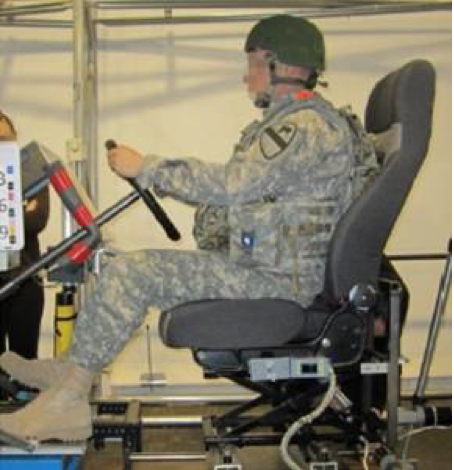Highly Equipped Soldiers and Vehicles: Finding the Right Fit

If you’ve ever felt like packing your car for a trip was like a game of Tetris, you can relate to the challenge of fitting a heavily equipped soldier into a military vehicle. A UMTRI team led by Professor Matthew Reed has now developed statistical models and tools to help solve the problem of fitting the warfighter into the war machine, and made those tools available to Army suppliers for vehicle design.
The average U.S. soldier now carries up to 100 pounds of gear including body armor, weapons, and equipment. In addition to the Advanced Combat Uniform (ACU), personal protective equipment (PPE) typically worn includes an improved outer tactical vest (IOTV), enhanced small arms protective insert (ESAPI) plates, enhanced side ballistic inserts (ESBI), and an advanced combat helmet (ACH). On top of the ACU and PPE, a soldier can additionally carry a hydration pack and a large amount of ammunition, communications gear, and other supplies. Although each of these elements is carefully designed by the Army for use in combat, bulky equipment can make it hard for the soldier to fit in a vehicle.
Matthew Reed, a Research Professor and head of the Biosciences Group of the University of Michigan Transportation Research Institute (UMTRI), led a team that conducted the first large-scale study of the posture and position of soldiers in vehicle seating scenarios. The 2012 Seated Soldier Study was carried out to capture the preferred posture and position of a soldier in a vehicle taking into consideration factors like clothing and equipment along with the placement and adjustability of steering wheel and other components. Reed used that data to develop methods and models to represent soldiers for vehicle design. The models are also publicly available for Army suppliers to use for creating military vehicles.
“This represents an entirely new approach for the Army for incorporating the needs of the soldiers into the vehicle design process,” said Reed. “We’re basically updating the process of designing Army vehicles to accommodate soldiers from the 1950s and 60s into the 21st century.” Reed said that the biggest challenge in designing military vehicle interiors is providing enough space for the warfighter inside the vehicle. The larger the vehicle is, the more armor it has and the heavier it is. That requires larger engines and a bigger powertrain, creating challenges for transportability. A smaller vehicle can be more maneuverable and efficient, but that then cramps the space allowed for soldiers. Models created by Reed provide an accurate representation of the space required by the soldier to allow vehicle designs to be optimized for their missions while preserving peak soldier performance.

The U-M team has based the new tools on extensive data gathered from soldiers at Army posts. Reed reports, “We’ve been fortunate to have an excellent collaboration with our Army colleagues that enables us to take our equipment to Army posts to gather data from actual soldiers.” Engineers and technicians in the Biosciences Group at UMTRI fabricate highly-adjustable seating mockups that enable a wide range of vehicle seating scenarios to be represented in portable test rigs. At the Army post, U-M researchers use coordinate measurement equipment to capture the postures and component-adjustment preferences of soldiers as they sit in the mockups. “These data are critical because they represent the realistic effects of soldier body armor and body-borne equipment on posture and position.” In the Seated Soldier study, the team used a laser scanner to capture three-dimensional body shapes of soldiers in seated postures. Among other applications, Reed’s team used these data to develop the anthropometric specifications for the Army’s new test dummy for underbody blast, known as the Warrior Injury Assessment Manikin.
Reed said the Army is benefiting from a unique capability at U-M. “Over the past 20 years, my group at the U-M Transportation Research Institute has developed a suite of statistical models used to represent occupant accommodation needs in the design of passenger cars and light trucks. About fifteen years ago we did the same thing for the heavy truck industry, creating models for truck and bus drivers. Over the past seven years, we’ve applied that approach and applied it to military vehicles, adding some innovations needed to address the unique needs of soldiers.” Reed said his research allows for truly human centered design of military vehicles, starting with the soldier and the mission and building the vehicle that best accommodates that.
Reed has now embarked on a new project to expand those accommodation models to address a wider range of vehicle interior design challenges. Reed and his group have gathered data using mockups of soldiers in commander and gunner positions in a vehicle. The study also quantified the effects of modern steering mechanisms and vision devices on driving postures.
In 2020, Reed’s group will conduct more data collection with soldiers to expand the generalizability of the models to take into account the effect of different seats and body armor. “We need to make sure our models are future proof,” Reed said.
ARC projects on this work include:
- Creating Encumbered Human Figure Models for Ergonomic Design and Assessment of Tactical Vehicles (link)
- Soldier-Centered Vehicle Seating Design Tools Based on Measurement and Modeling of Soldiers (link)
- Measuring and Modeling the Effects of Encumbrance on Seated Reach (link)
- Modeling and Simulation to Assess and Demonstrate Airbag Technology for Occupant Protection in Tactical Vehicles (link)
Stacy W. Kish

